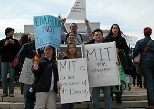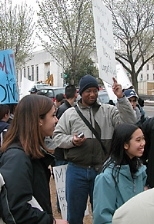Some of the 55 MIT students who traveled 10 hours overnight by bus to Washington to march for civil rights on the day the U.S. Supreme Court heard arguments on the University of Michigan affirmative action case will reflect on their trip Thursday evening, April 17.
Several of the students will read from written journals and others will speak extemporaneously at a dinner-reception in the Stratton Student Center's La Sala de Puerto Rico from 6:30 to 8:30 p.m. There will also be a slide show, video and audio clips from the rally and an update on affirmative action cases.
Kasetta V. Coleman, a junior in materials science and engineering, had personal reasons to help organize MIT's participation in the rally. As a student in Philadelphia public schools, where many of her peers barely made it through high school, she is keenly aware of inequities in the educational system. She also felt it was important to provide visible support for MIT's amicus curiae brief in the Michigan suit.
"My parents didn't go to college and I really had no one but myself to help me with the college application process," said Coleman, a member of the Black Students' Union. "Affirmative action or not, I feel like I've worked much harder than a lot of people who've gotten into schools like MIT. Unfortunately many people mistakenly assume that the standards are dropped because you are an underrepresented minority student.
"That is not the case at all. MIT doesn't just give anyone an invitation to be a part of its community. The Office of Admissions makes sure that that incoming student will be able to succeed in this type of environment. MIT has a reputation to uphold and the quality of this school, and other top caliber universities, has only increased with the initiative to help create a more diverse and tolerant student and staff community."
The MIT students, chanting and carrying signs, joined thousands of their peers from across the country on April 1 outside the Supreme Court building while the arguments went on before the nine justices.
When the court session concluded, the demonstrators marched down Constitution Avenue and across the mall to the Lincoln Memorial, where they listened to speeches and sang "Lift Ev'ry Voice and Sing."
Sasha Devore, a graduate student in electrical engineering and computer science, was pleased that the rally attracted a diverse group "representing many facets of America."
"It was especially encouraging to see all the young high school-aged students who are involved in the civil liberties movement," she said.
The return trip took more than 10 hours due to mechanical problems with the bus. They arrived back on campus at 4 a.m.
The students were accompanied on the 36-hour excursion by Rick Gresh, assistant director of Student Life Programs, and Michèle Oshima, director of special programs in the Office of the Arts. The trip was sponsored by "BSU: The Rallying for Education Project."
The dinner-reception is sponsored by the Black Students' Union and La Unión Chicana por Aztlán. Admission is free and the public is invited. For more information, see http://eb.mit.edu/bsu/www or e-mail bsu-exec@mit.edu.
A version of this article appeared in MIT Tech Talk on April 16, 2003.







